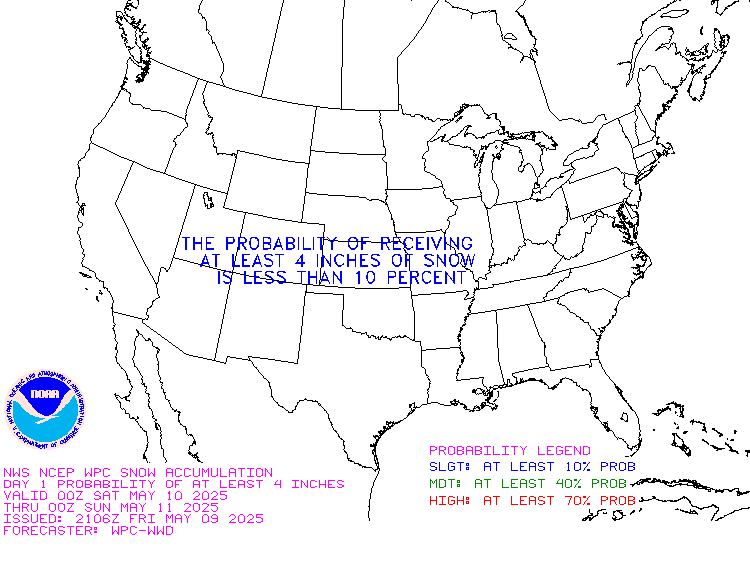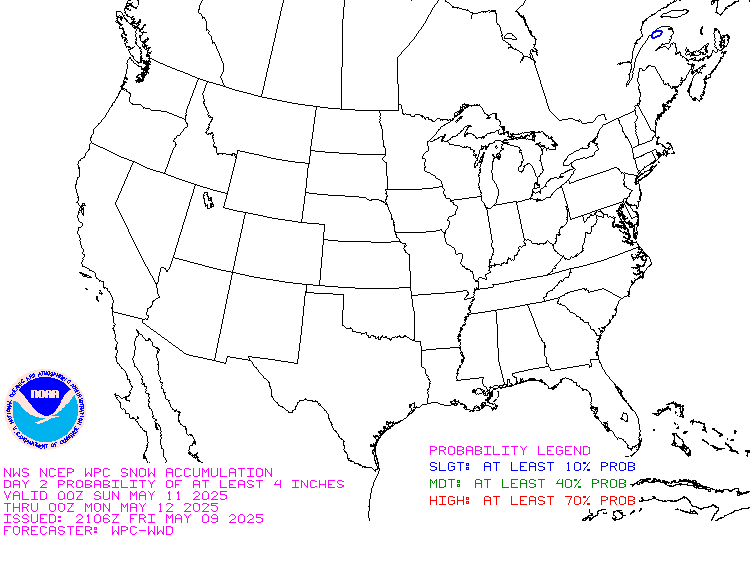It is difficult to find a more comprehensive Weather Outlook anywhere else with the ability to get a local 10-day Forecast also.
This article focuses on what we are paying attention to in the next 48 to 72 hours. The article also includes weather maps for longer-term U.S. outlooks and a six-day World weather outlook which can be very useful for travelers.
First the NWS Short Range Forecast. The afternoon NWS text update can be found here but it is unlikely to have changed very much. The images in this article automatically update.
Short Range Forecast Discussion
NWS Weather Prediction Center College Park MD
Mon Apr 15 2024
Valid 12Z Mon Apr 15 2024 – 12Z Wed Apr 17 2024…Intensifying storm system to bring the threat of severe weather and
isolated flash flooding to the Plains Monday, followed by the Mississippi
Valley on Tuesday……Scattered thunderstorms, including the threat for some severe weather,
from the Upper Ohio Valley east through the Mid-Atlantic Monday……Moderate to locally heavy snowfall expected over the next couple of
days for higher elevations of the northern Cascades, northern/central
Rockies, and eastern Great Basin……Well above average temperatures across the Central/Eastern U.S;
Critical Risk of Fire Weather for the central/southern High Plains
Monday….A deep, upper-level low and associated low pressure/frontal system over
the West will begin to push into the Plains Monday. The accompanying
height falls will help lead to lee cyclogenesis, rapidly
deepening/organizing the low pressure system over the central High Plains.
Gulf moisture return aided by intensifying southerly flow will eventually
lead to increasing shower and thunderstorm chances by Monday evening to
the northwest of the low over the central/northern High Plains, along a
warm front slowly lifting northward through the Missouri and Middle
Mississippi Valleys, and southward ahead of a dry line/rapidly approaching
cold front through the central and southern Plains. An Enhanced Risk of
severe thunderstorms (level 3/5) has been issued by the Storm Prediction
Center from the low pressure center in western Nebraska/South Dakota
arcing southward ahead of the approaching dry line/cold front across
portions of the central Plains. Some more robust, supercell thunderstorms
are expected to produce instances of very large hail, damaging winds, and
a few tornadoes. A Slight Risk (level 2/5) extends southward into the
southern Plains where storm coverage is more uncertain, but any storms
that do develop will still pose the same threat. Additionally, there will
be a conditional threat for some isolated instances of flash flooding,
both along and north of the warm front from the Northern Plains into the
Missouri Valley where widespread, but not quite as potent storms will
exist, and south into portions of the central/southern Plains where more
potent storms will exist, but drier antecedent conditions will limit the
risk.The storms will progress eastward with the frontal system through the
overnight hours Monday and into the day Tuesday, spreading into the
Mississippi Valley, Great Lakes, and Ohio Valley. Areas where residual
storms from the night before clear, most likely through the Middle
Mississippi Valley southwestward into the Ark-La-Tex, will see a renewed
threat for severe thunderstorms. Another Enhanced Risk has been issued for
portions of southern Iowa, northern Missouri, and western Illinois near
the track of the low pressure center where favorable wind fields will lead
to a locally greater threat of very large hail, damaging winds, and
tornadoes, including the potential for a strong tornado. A Slight Risk
once again extends further south towards the Ark-La-Tex where storms will
likely be more isolated, but still pose a threat for all hazards. A broad
threat for isolated flash flooding will exist over the region very similar
to Monday, with more widespread storms to the north and more isolated but
potent downpours possible to the south.Further east, another round of storms is expected Monday along and ahead
of a cold front sagging southward through the Upper Ohio/Tennessee Valleys
eastward through the southern Mid-Atlantic. There is a Slight Risk of
severe weather centered around the Tidewater region of Virginia where
enough CAPE for some stronger updrafts will exist, posing a threat for a
few instances of large hail and damaging winds. In the West,
winter-weather related advisories/warnings are in place for higher
elevations of the mountains of the eastern Great Basin and central Rockies
where remaining moisture under the influence of the upper-low is forecast
to lead to snow accumulations of 6-12″+. Another upper-level wave and
accompanying surface frontal system pushing southeastward through the
Cascades Monday and northern Rockies Tuesday will bring a similar chance
for moderate to locally heavy snowfall for higher mountain elevations.Warmer than average temperatures will continue Monday for most areas of
the central/eastern U.S. as upper-level ridging precedes the system over
the West. Highs generally in the 80s are expected across the
central/southern Plains east through the Mississippi Valley and into the
Mid-Atlantic/Southeast. A few 90s will even be possible over the
central/southern High Plains. These hot temperatures and dry conditions,
along with intensifying winds due to the deepening low pressure system,
have prompted a Critical Risk (level 2/3) of Fire Weather from the Storm
Prediction Center Monday. Warm, similarly above average highs are also
expected across the northern tier, with most locations outside of the
Upper Great Lakes/Interior Northeast forecast to be in the 60s and 70s.
Temperatures will slip a few degrees in general Tuesday, but still remain
above average for most locations. Cooler temperatures will continue Monday
across southern portions of the West under the influence of the upper-low,
with 50s and 60s across California and the Great Basin and 70s in the
Desert Southwest. Conditions will rebound by about 10 degrees on Tuesday
as the upper-low moves eastward over the Plains.
To get your local forecast plus active alerts and warnings click HERE and enter your city, state or zip code.
Above is a 72 hour animation of the forecast. Learn about wave patterns HERE.
Then, looking at the world and of course, the U.S. shows here also. Today we are looking at precipitation.
Please click on “Read More” below to access the full Daily Report issued today.
| Notices: What would you like to learn about? Please provide that to me via the comment section at the end of the article. |
Now more detail on the 48-Hour Forecast (It is a 48 to 72 Hour Forecast actually)
Daily weather maps. The Day 1 map updates twice a day and the Day 2 and 3 maps update only once a day. These maps update automatically. But if that does not happen, you can get updates by clicking HERE
TODAY (or late in the day the evening/overnight map will appear) (Key to surface fronts shown on maps and you will then also be able to insert a city name or zip code and get a local NWS forecast).
TOMORROW
NEXT DAY
This animation shows how things may play out over the next 60 hours. To update click here.
The NWS Climate Prediction Center’s: Watches, Warnings, and Advisories plus other information can be found HERE. We post at least one of those updates daily, sometimes both. The Highlights are shown in the lede paragraph of this article.
ATMOSPHERIC RIVERS
This tells us what is approaching the West Coast. Click HERE to update If I have not gotten around to doing the update. Here is some useful information about Atmospheric Rivers.
Below is the current five-day cumulative forecast of precipitation (Updates can be found HERE)
Ski SnowReports
New Feature – Ski Reports. It is difficult to find reports that auto-update on-screen (and they are very long) but these links will get you to them – If you have additional suggestions make them in the comments section after every Econcurrents Article and we may add those links. We will try to not have too much overlap as that can add to the confusion.
Snow Forecasts. And remember this shows natural snow. Ski resorts also make their own snow.
Day 1

Day 2

Additional snow information can be found here, here, here, and here. The second link provides animations.
Now we look at Intermediate-Term “Outlook” maps for three time periods. Days 6 – 10, Days 8 – 14, and Weeks 3 and 4. An outlook differs from a forecast based on how NOAA uses these terms in that an “outlook” presents information as deviation from normal and the likelihood of these deviations.
Below are the links to obtain updates and additional information. They are particularly useful if you happen to be reading this article significantly later than when it was published. I always try to provide readers with the source of the information in my articles. These links may also be useful for those viewing this article on a cell phone or other small screen.
| Days 6 – 10 (shown in Row 1) | Days 8 – 14 (Shown in Row 2) | Weeks 3 and 4 (Shown in Row 3 but updates only on Fridays) |
| https://www.cpc.ncep.noaa. gov/products/predictions/610day/ | https://www.cpc.ncep .noaa.gov/products/predictions/814day/ | https://www.cpc.ncep.noaa.gov/products/predictions/WK34/ |
Showing the actual maps. They should now update automatically. The Week 3 – 4 Outlook only updates on Fridays. So below is what I call the Intermediate-term outlook. On Fridays, it extends out 28 Days. That declines day by day so on Thursday it only looks out 22 days until the next day when the Week 3 – 4 Outlook is updated and this extends the outlook by one additional week.
| 6–
10
|
|
|
| 8–
14 |
|
|
| 3–
4 |
|
|
HAZARDS OUTLOOKS
Click here for the latest complete Day 3 -7 Hazards forecast which updates only on weekdays. Once a week probably Monday or Tuesday I will update the images. I provided the link for readers to get daily updates on weekdays. Use your own judgment to decide if you need to update these images. I update almost all the images Friday Night for the weekend edition of this Weather Report. So normally readers do not need to update these images but if the weather is changing quickly you may want to.
Temperature month to date can be found at https://hprcc.unl.edu/products/maps/acis/MonthTDeptUS.png
Precipitation month to date can be found at https://hprcc.unl.edu/products/maps/acis /MonthPNormUS.png
World Forecast [that website is has been intermittent so be patient]
Below are the Day 1 -3 and 4-6 forecasts for temperature and precipitation. Updates and much additional information can be obtained HERE
World Temperature Anomalies
World Accumulated Precipitation
This information is provided by the University of Maine. They draw upon many different sources. There is a lot of information available at the link provided. I have just provided two useful forecasts. There are probably over a hundred different forecasts available from this source.
Worldwide Tropical Forecast (This is a NOAA Product)
This graphic updates on Tuesdays) If it has not been updated, you can get the update by clicking here Readers will only have to do that if they are reading this article much later than the date of it being published.
Information on Tropical Storms can be found HERE. Western Pacific information can be found HERE. Note that unless there is an out-of-season storm the below images will not update until the National Hurricane Center starts their seasonal update of these maps on June 1. I include them simply because there can be an out-of-season event in which case it should show up in these maps.


–
| I hope you found this article interesting and useful. |
–
